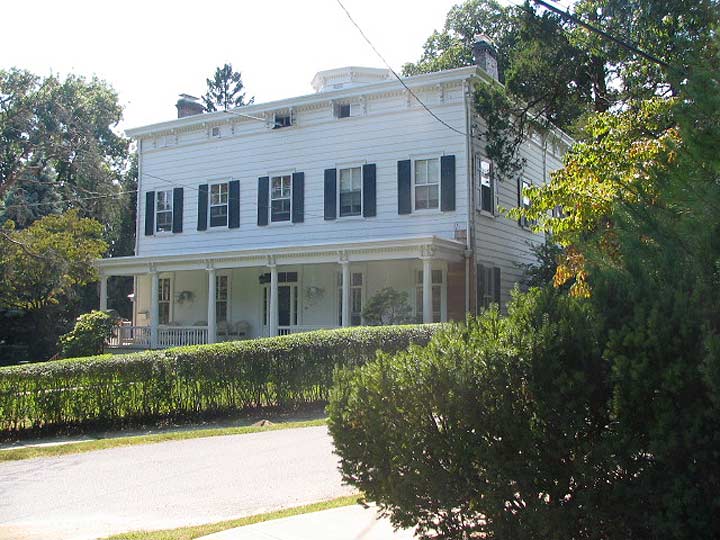Tucked away in tony Douglaston are a few buildings that go back to the colonial and postcolonial era. One of these is the Greek Revival Allen-Beville House at 236-12 Center Drive at Forest Road. Though Douglaston has Queens-style hyphenated address numbers, most of its streets carry suburban-style names. Apparently there was once an effort to bring Douglaston’s streets into line with the rest of the borough and assign them numbers — Hagstrom maps had numbered Douglaston streets into the 1970s, and for all I know they once were numbered (let me know at kevinjudewalsh@gmail.com). More recently, Douglaston Hill streets south of the LIRR and north of Northern Boulevard were given names to replace the numbers.
The Allen-Beville house immediately stands out from its neighbors — it’s a big house, wedding cake white on a large plot, with Doric-columned porch, clapboard sides, large center entrance door, and octagonal cupola that no doubt once had a great view of Long Island Sound.
This land was first occupied by the Matinecoc Indians, who were largely forcibly expelled by Britisher Thomas Hicks in a battle at today’s Marathon Parkway and Northern Blvd (the corner has been given the name Matinecoc Way). The Native Americans’ cemetery at Northern Boulevard and Browvale Lane was removed when Northern Boulevard was widened in the 1920s and 1930s, the remains reinterred at the Zion Church Cemetery at a split marker that says “Here rest the Last of the Matinecoc.” That’s not quite true, as members of the old tribe, members of the Waters family, still reside in old homes along Little Neck Parkway and Marathon Parkway.
After Hicks much of the Douglaston peninsula was owned by the Van Wyck and Van Zandt Dutch families, who then sold to George Douglas who ultimately gave the peninsula his name via his son William. Towns sprang up like Douglas Manor and Marathon, named for a fifth century BC battle during a Persian invasion of the Greek peninsula; a soldier named Pheidippedes relayed news of the Athenian victory to its ruler along a course of 26 miles. The only remnant in Queens of the town of Marathon is the lengthy parkway and another avenue named for Thebes.
Benjamin Allen, a farmer who built this building himself in the 1840s and who with his wife raised seven children, owned property in Marathon. Allen was a vestryman in Zion Episcopal Church, established in 1830 in the same spot where the current church, built in the 1920s, stands off Northern Boulevard. William Douglas purchased the house from the Allen estate, using it as a guest house for his nearby manor. He was an enthusiastic yachtsman and won a race that after a few reorganizations became the America’s Cup. In 1946 the house was purchased by Mr. and Mrs. Hugh Beville, and under their ownership, the house was landmarked by NYC.
Much more by Montrose Morris in Brownstoner.
“Comment as you see fit” kevinjudewalsh@gmail.com
1/12/17

